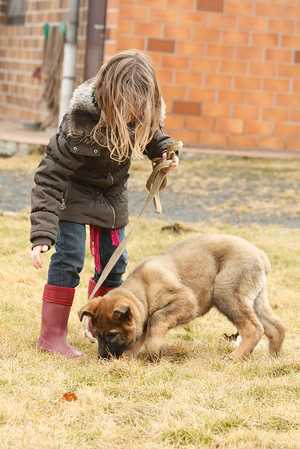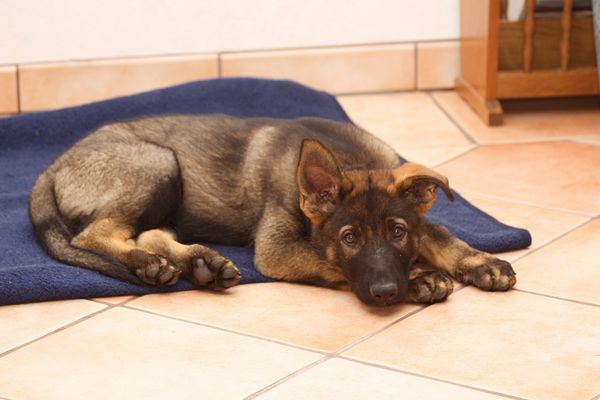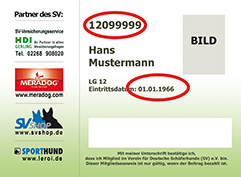The home
An unknown environment, strange smells and strange voices – your puppy is getting thrown into a totally new world. So avoid additional stress in this new situation for the dog and, if necessary, slow down the torrents of enthusiasm from people (including children) in the house, so as not to scare the already unsettled dog. Give the puppy enough time to get to know its new family – its new pack – and to build trust. Let your puppy explore its new home in peace, and have a supply of kitchen towels ready to remove the first puddles of excitement. Don’t scold: the little one still doesn’t know any better!
Show it its bed and its eating area. In the first few weeks, lock doors to children’s rooms, guest rooms, storage rooms and other ‘retreats’ where the little one might do its business undisturbed, destroy something or put itself at risk. Make your home puppy-safe!
Place poisonous plants, cleaning agents, but also expensive carpets etc. out of the curious, clumsy puppy’s reach. Insulate power cables, and secure danger spots such as stairways and exits, balconies, garden ponds and pools with baby gates and fences if necessary – especially if the little explorer is unsupervised. Once the young dog has made it through its clumsy phase and internalised the rules, its territory can be confidently expanded.
In the pack
Basic upbringing has already begun: the mother dog showed her child who leads the pack with loving consistency. That is exactly what the puppy now expects from you.
Establish the hierarchy on the first day: once you define rules and commands, they must always apply. Don’t let supposedly small mishaps like chewed slippers or biscuits stolen from the table pass as ‘beginner’s mistakes’ – no matter how innocent the dog’s eyes are. Your puppy needs boundaries. If there are no boundaries or if boundaries are unclear, the dog will decide for itself when in doubt and will soon take over the pack!
The dog bed
Until now, the puppy has been able to cuddle with its siblings day and night. Now it has to learn to sleep alone. Some puppies fall asleep exhausted after the excitement of the first day, while others whimper or howl loudly, always looking for their mother and their littermates. Show your newcomer its basket or box to sleep in. Place something familiar from the breeder and something from the puppy’s old home (blanket, old clothing or straw). Push it in gently and give the command ‘bed’. It is important that the command is used by all family members. Even though it might be hard, the puppy should sleep in its bed right from the start. You can prevent the puppy from climbing into your bed by repeatedly pushing it back into its basket. Don’t pet it until it stays put there.
.
Praise and reprimand
Give your puppy short, concise commands and don’t be shy about showering it in praise for good behaviour. This can be a friendly ‘good boy/girl’, a pet, a gentle knock, a snack or a favourite toy. Positive affirmation of behaviour leads to more effective learning than pressure and reprimand. Basic principle: if your puppy shows unwanted behaviour, ignore it – that too is punishment. If desired behaviour occurs, praise it immediately, i.e. within the next two seconds. This requires close observation and quick action. If the dog follows some commands correctly, do not praise it with every success, but instead, let it practice ‘dry’ from time to time. Reprimand, on the other hand, only makes sense if you catch your dog in the act and are able to respond directly. End a game that becomes too aggressive by gently pushing the dog away or removing it from the situation. If you take away objects that it’s not allowed to have, don’t yell – a calm, firm ‘no’ or ‘out’ is sufficient. Punishing it with a leash or rolled-up newspaper is an absolute no-go!
Animals subjected to this treatment often have trouble trusting humans and can become insecure. If your dog reacts aggressively, or if you are even afraid of your animal, seek advice from experienced dog trainers.
Toilet training
As soon as it arrives, lead your puppy directly to the place where you want it do its business (i.e. not in the middle of the garden or on the footpath). Dogs like to relieve themselves in the same place. Go outside with the puppy at regular intervals. In the meantime, keep a close eye on it! Is it walking around restlessly? Does it start whimpering, searching or sniffing the floor? This is usually a sure sign that ‘business’ needs to be done soon. If the little one makes it out in time and does its business ‘successfully’, give it extensive, but calm praise. Take the puppy back to its usual bathroom spot as late in the day as possible. But don’t be disappointed if you find a puddle every now and then during the day. Don’t scold. Instead, ignore the mishap (if you don’t catch it red-handed). This is part of the normal learning process. An odour neutraliser from a specialised retailer will help make sure the puppy doesn’t try to visit the ‘accident site’ again.
Leash training
Before the leash comes into play, put a loose collar on your puppy. If it seems bothered by the collar, distract it with a game or a snack. Do the same thing with a loose leash. Let it sniff in peace and get the dog to walk with you using a treat – don’t pull on the leash! It’s best to get the puppy used to walking on the leash to your left, next to your leg. If the dog pulls on it, change the direction of walking immediately. The dog must learn to focus on your movements. If no fenced yard is available, practice the command ‘come’ or ‘here’ on an extra-long leash. Squat down and clearly call out your dog’s name. If it comes to you directly, it deserves a lot of praise. Don’t walk towards your puppy and don’t call it too often, otherwise it may get used to not having to react. Always keep your protégé on a leash until it can master this exercise safely.
With children

Teach young children how sensitive and anxious the puppy will be when they get loud and hectic. Show them how to handle the animal properly and make sure that the puppy is never pulled by the tail or ears – it could bite as a reflex! They should be kept away from the food bowl and the dog’s bed for the time being until the hierarchy has been established. Never let the puppies play with young children unsupervised. Older children can be involved in the training and care of the puppy – as long as you make sure that the work that needs to be done is taken care of. If other children come to visit, ensure that the dog is not in the room when they’re running around or play-fighting. It might take sides with ‘it’s pack’ and defend them. If you do not have any children of your own, introduce your puppy to the children of friends and family on a regular basis so that they can get used to little ones.
With other animals
You need to be very patient when introducing the new arrival and any other pets to one another. When two dogs meet, both should both be kept on a leash as long as they don’t yet get on perfectly with one another. Please never leave them unattended. If you encounter any dogs you don’t know, don’t just let your puppy run towards them, and do keep it on a leash. The so-called ‘puppy licence’ only applies to a dogs’ own pack, not to strangers. Guide it towards other animals, such as cows, horses, cats and birds, just as gently, and then move past them naturally and without any sudden movements. If your puppy has a hunting tendency, it is important to put a stop to it immediately! If necessary, devote extra time to practising ‘non-hunting’.
Basic voice commands
Once you’ve got through the first few days and the puppy has (gradually) learnt the basic rules of behaviour, you can introduce it to voice commands. They are important so that you can keep the dog under control at all times. Do not move on to the next task until the previous exercise is done. Combine training and play. In the first few days and weeks, get your puppy used to being brushed and examined thoroughly (open its mouth, look in its ears etc.). You should also be able to take the food bowl, bone, stick or toy out of the dog’s mouth without it growling. These exercises are very important for vet visits and encounters with dangerous or poisonous objects that the dog may pick up.
Gradually, the puppy should also be introduced to everyday noises such as the hoover, lawn mower or drill, because fighting with the hoover is only funny when the dog is still a puppy.
Sit! Down! Stay!
Hold a treat between your thumb and index finger and let the puppy sniff it. Pull your hand and the treat slowly over its head to the back – low enough so that the dog doesn’t jump. As soon as it is about to sit (because it doesn’t want to lose sight of its prey), give the command ‘sit’ and give the dog its reward. After just a few repetitions, it will sit down expectantly when it hears this command. The ‘down’ exercise is best carried out when the dog is already sitting. Hold a treat in your closed hand and pull it from the dog’s nose down to the floor. If you have to help it lie down, then only do so applying gentle pressure on the shoulder. Once the dog is lying on the floor, give it praise and reward it with the biscuit. For the ‘stay’ exercise, start with your dog sitting or lying down. Back away slowly and give the ‘stay’ command very calmly. Maintain eye contact and correct the dog immediately if it tries to get up. Praise it for the first few metres. You can gradually increase the distance and amount of time the dog stays.







